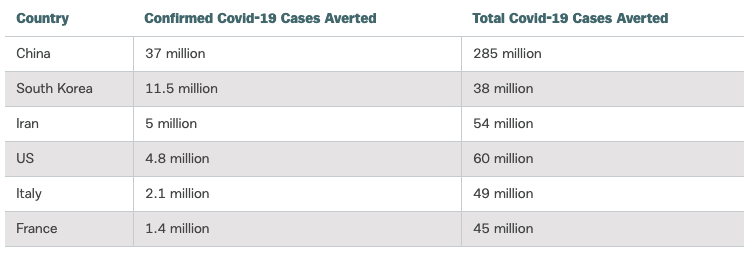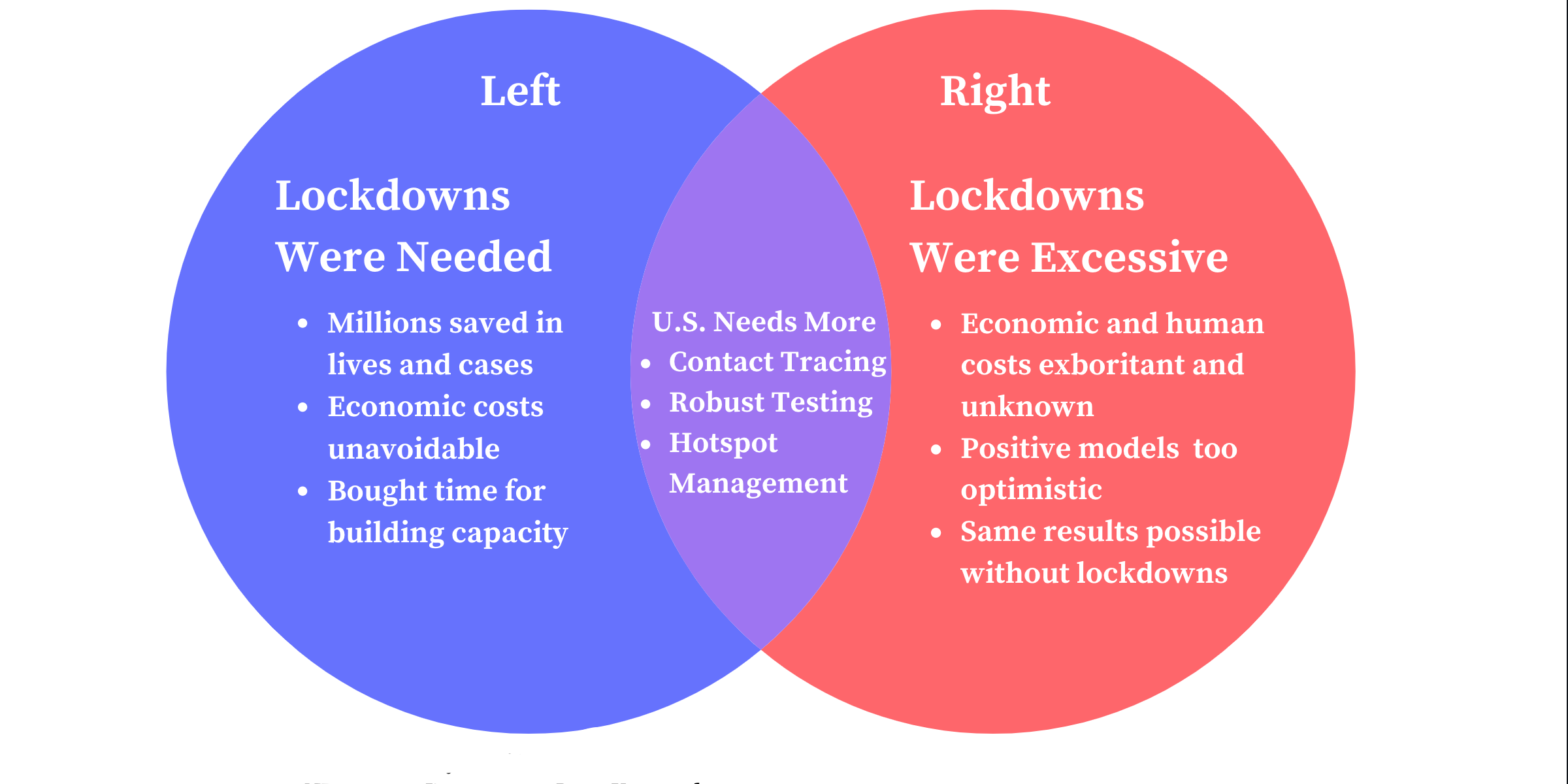As much as Covid-19 has been a health pandemic, it has also been a pandemic of disagreement, particularly when it comes to lockdowns, in terms of both their effectiveness at stopping the spread of the virus and their relative costs for society. There is a fairly consistent divide in how the left and right view lockdowns (unlike with the efficacy of mask use, which the left and the right generally agree upon, even if the American public hasn’t always followed through).
News outlets on the left and center generally posit that lockdowns, despite known and considerable costs, saved many human lives. The right, on the other hand, is less sure, claiming immense economic costs and uncertain effectiveness, with some adamant that lockdowns were the wrong policy action altogether.
With states at all different levels of reopening and cases rising in many reopened states in recent days, the value of lockdowns as a policy tool is more critical than ever. Is there ample evidence that lockdowns work, or enough at least to justify new rounds of closures if needed? Did the lockdowns prevent negative outcomes or merely delay them? Here we investigate where the left and right agree as well as where they disagree and why.
Did Stay-at-home Orders Save Lives?

Source: Hsiang et al. via Vox
This is the big point of contention, and while it’s easy to paint this as a two-sided issue, right versus left, it’s not so clear cut. The hallmark evidence for the efficacy of lockdowns seems to largely come from two studies published in Nature in the beginning of June: (1) a study of 11 European countries that showed lockdown measures averted 3.1 million deaths, and (2) a study of six countries — the U.S., China, Iran, France, Italy, and South Korea — that shows the orders delayed or avoided as many as 530 million infections, including 60 million in the U.S. This evidence has been reported on the left, right, and center, albeit with a range of skepticism.
“These studies show yet again that no matter how painful they are, shutdowns do work at saving lives and reducing the burden on the health care system.” – Vox
Please check your email for instructions to ensure that the newsletter arrives in your inbox tomorrow.
The popular intuition on the left seems to be that lockdowns were essential, with some even suggesting that delays in the implementation of stay-at-home orders cost thousands of lives. The right, however, offers many dissenting viewpoints. Chief among them is the belief that lockdowns were a blunt and unnecessary instrument, imposing untold costs on society — including an estimated 1.5 billion children out of school globally, trouble feeding nearly 135 million food insecure people worldwide, and delayed routine medical services — without proven justification. Where there are models that put lockdowns in a positive light, there are also ones that question their value.

Source: RealClearPolitics
The Costs of Lockdowns
Another obvious place of disagreement is the relative cost of the lockdowns. Articles on the left acknowledge the immense economic and societal costs of lockdowns and generally argue that the value of lives saved far surpasses the value of foregone economic activity: “the economic benefits from lives saved by efforts to ‘flatten the curve’ outweighed the projected massive hit to the nation’s economy by a staggering $5.2 trillion.” By contrast, articles on the right tend to argue that such foregone economic output has placed incalculable costs on the public in terms of reduced earning potential and therefore a host of health and mental problems, including a 2-3 times higher risk of suicide and a sizable decline in hospital visits. These same interpretations have also been suggested on the left (costing “millions of years of American life”) and contested just as quickly.
“Targeted measures aimed at curtailing superspreading—such as masks, social distancing rules, and restrictions on large, crowded gatherings, especially indoors—are likely to be more cost-effective than broad business closures and stay-at-home orders.” – Reason
In all likelihood, a definitive answer to these questions won’t emerge for some time. Not only will there be an ongoing debate about which numbers to use and how to make these calculations, some parts of the U.S. remain in lockdown, and worsening situations in reopening states are providing new data on the lockdown versus business-as-usual dynamic. Both sides do agree that the costs of Covid-19 and the lockdowns are undoubtedly most felt by the poorest parts of society, including rural and minority populations. The case has also been made that much of the immense economic costs would be felt, lockdowns or not, as the pandemic alone deters consumer spending and makes many adopt lockdown-type behavior without the stay-at-home orders.
Case Study: Sweden
Sweden stuck out as an early case of a country that was eschewing lockdowns for less stringent measures, including social distancing and forbidding mass gatherings. Articles on the right pointed to Sweden’s relatively low case count as evidence that lockdowns weren’t critical to averting disaster. Though Sweden has even maintained growth while other Nordic countries have not, Sweden is showing signs of regretting the decision to not issue lockdown orders.
“The country has among the highest per capita mortality rates in the world with over 43.2 deaths per 100,000 inhabitants, far higher than in neighboring Denmark, Finland and Norway, with 9.9, 5.8 and 4.4 deaths per 100,000, respectively, according to data compiled by Johns Hopkins University.” – Wall Street Journal (as of June 3, 2020)
In that Sweden has a lower infection rate than the United Kingdom, Spain, and Italy — places that all had lockdowns — there may be an argument against such orders. But in the context that Sweden now has one of the highest death rates in the world, at 49.62 deaths per 100,000 people, higher than the United States and Brazil, it’s not surprising that the decision not to lock down is being viewed as a mistake. That said, Sweden is but one example, and the full story may not be known for months.
Where Americans Agree

The focus on lockdowns as good or bad overshadows where there seems to be real agreement: the country needs robust contact tracing, improved testing capability, and the ability to tailor responses to disease hotspots. While some see lockdowns as a boon insofar as they may have saved countless lives while allowing the U.S. to build such capacity, others see them as an unnecessary burden in pursuit of building up those same tools. There’s broad agreement that those tools and social distancing, not broad lockdowns, represent a sustainable solution in terms of coexisting with the virus until a vaccine is made widely available.
Please check your email for instructions to ensure that the newsletter arrives in your inbox tomorrow.
So while the debate over whether lockdowns were worth it will rage on, and the answer will differ depending on who you ask, what the parameters of the question are, and what data you choose to use, Americans for the most part see that lockdowns are not a long-term solution. Successive rounds of lockdowns could be increasingly costly and more politically contentious. Case counts have spiked in recent days in states such as Texas, Florida, Arizona, California, and Oklahoma, and the left, right, and center agree this is not just due to increased testing. This raises the question of whether a new round of lockdowns is around the corner, not just at home but around the world. Indeed, the story of lockdowns is not yet fully written.
Recommended Articles
Left:
“2 new studies show shutdowns were astonishingly effective” – Vox – Credibility Grade: 82%
(Author: Umair Irfan; June 9, 2020)
“The Best Global Responses to COVID-19 Pandemic” – Time Magazine – Credibility Grade: 78%
(Author: Ian Bremmer; June 12, 2020)
“Health Experts Link Rise In Arizona Coronavirus Cases To End Of Stay-At-Home Order” – NPR – Credibility Grade: 90%
(Author: Will Stone; June 14, 2020)
Center:
“Studies Estimate That Lockdowns Slowed COVID-19 Spread and Saved Lives” – Smithsonian Magazine – Credibility Grade: 86%
(Author: Theresa Machemer; June 15, 2020)
“Coronavirus destroys jobs and worsens inequality, with or without full lockdown” – The Conversation – Credibility Grade: 73%
(Author: Tim Lee; June 9, 2020)
“Mulling the Allure and Peril of State Power Amid Covid-19” – Undark – Credibility Grade: 90%
(Author: Michael Schulson; May 29, 2020)
Right:
“Unnecessary Lockdowns Created Social Turmoil, Global Suffering” – RealClearPolitics – Credibility Grade: 83%
(Author: Yinon Weiss; June 11, 2020)
“How Many COVID-19 Infections and Deaths Did Lockdowns Avert?” – Reason – Credibility Grade: 89%
(Author: Ronald Bailey; June 9, 2020)
“Did the Lockdowns Work?” – National Review – Credibility Grade: 60%
(Author: Robert Verbruggen; May 22, 2020)

